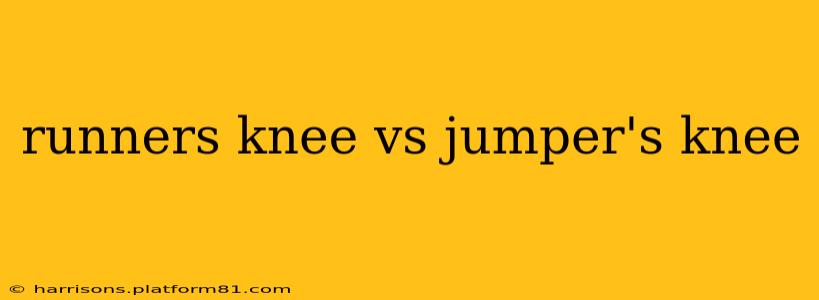Both runner's knee and jumper's knee are common knee pain conditions, often causing confusion due to their similar-sounding names. While both involve pain around the kneecap (patella), they stem from different causes and often manifest differently. This article will clarify the distinctions between these two conditions, helping you better understand your knee pain and seek appropriate treatment.
What is Runner's Knee?
Runner's knee, also known as patellofemoral pain syndrome (PFPS), is a broad term encompassing pain around the kneecap. It's frequently associated with overuse injuries in runners, but it can affect anyone whose activities put repetitive stress on the knee joint. The pain isn't localized to one specific point but can be felt around the kneecap, behind it, or even down the side of the leg.
Causes of Runner's Knee: The underlying causes of runner's knee are diverse, often involving a combination of factors:
- Overuse: Repeated stress on the knee joint from activities like running, cycling, or even prolonged sitting.
- Muscle imbalances: Weakness or tightness in the muscles surrounding the knee, particularly the quadriceps, hamstrings, and hip muscles, can lead to improper patellar tracking.
- Poor running form: Incorrect running technique, such as overstriding or inward rolling of the feet (pronation), increases stress on the knee joint.
- Biomechanical issues: Foot problems like flat feet or high arches, leg length discrepancies, and knee alignment issues contribute to uneven stress distribution across the knee.
What is Jumper's Knee?
Jumper's knee, or patellar tendinitis, is a specific type of tendinopathy affecting the tendon that connects the kneecap to the shinbone (tibia). Unlike runner's knee, which is more diffuse, jumper's knee typically causes pain directly below the kneecap, often accompanied by tenderness and swelling. This condition is common in athletes involved in jumping sports, such as basketball, volleyball, and high jump, hence its name.
Causes of Jumper's Knee:
- Overuse: Repeated jumping and landing stress the patellar tendon, leading to microscopic tears and inflammation.
- Sudden increases in activity: A sudden increase in training intensity or volume without proper conditioning can overwhelm the tendon's capacity.
- Poor training techniques: Incorrect landing technique during jumping activities places excessive strain on the patellar tendon.
- Improper footwear: Inadequate support or cushioning in footwear can contribute to increased stress on the knee.
Runner's Knee vs. Jumper's Knee: Key Differences Summarized
| Feature | Runner's Knee (PFPS) | Jumper's Knee (Patellar Tendinitis) |
|---|---|---|
| Pain Location | Diffuse pain around kneecap | Localized pain below kneecap |
| Primary Cause | Overuse, muscle imbalances, biomechanics | Overuse, repetitive jumping, poor technique |
| Affected Area | Patellofemoral joint | Patellar tendon |
| Typical Athlete | Runners, cyclists | Jumpers, basketball, volleyball players |
What are the symptoms of runner's knee?
Symptoms of runner's knee can vary depending on the severity of the condition but generally include:
- Pain around the kneecap, especially after activity or prolonged sitting.
- Stiffness in the knee, particularly in the morning.
- Swelling or tenderness around the kneecap.
- A clicking or grinding sensation in the knee.
- Pain that worsens when going up or down stairs.
What are the symptoms of jumper's knee?
Symptoms of jumper's knee typically include:
- Pain below the kneecap, often worsening after jumping or landing.
- Tenderness to the touch below the kneecap.
- Swelling and stiffness in the affected area.
- Pain that may radiate down the shin.
- A feeling of tightness or stiffness in the tendon.
How are runner's knee and jumper's knee diagnosed?
Diagnosis usually involves a physical examination, assessing the location and nature of pain, range of motion, and muscle strength. Imaging studies, such as X-rays or MRI scans, may be necessary to rule out other conditions. A detailed medical history, including activity levels and past injuries, is essential for accurate diagnosis.
How are runner's knee and jumper's knee treated?
Treatment for both conditions often involves conservative methods initially:
- Rest: Avoiding activities that aggravate the pain.
- Ice: Applying ice packs to reduce inflammation.
- Compression: Using a compression bandage to support the knee.
- Elevation: Keeping the leg elevated to reduce swelling.
- Physical therapy: Strengthening exercises to improve muscle balance and stability.
- Pain medication: Over-the-counter pain relievers such as ibuprofen or naproxen.
In more severe or persistent cases, other treatment options may be considered, such as:
- Corticosteroid injections: To reduce inflammation (not a long-term solution).
- Surgery: In rare cases, surgery may be necessary to repair damaged tendons or address underlying anatomical issues.
It is crucial to consult with a healthcare professional or physical therapist for an accurate diagnosis and personalized treatment plan for either runner's knee or jumper's knee. Early intervention and appropriate management can help prevent long-term problems and ensure a faster recovery.
